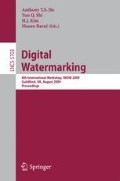Abstract
Detecting the (brands and) models of digital cameras from given digital images has become a popular research topic in the field of digital forensics. As most of images are JPEG compressed before they are output from cameras, we propose to use an effective image statistical model to characterize the difference JPEG 2-D arrays of Y and Cb components from the JPEG images taken by various camera models. Specifically, the transition probability matrices derived from four different directional Markov processes applied to the image difference JPEG 2-D arrays are used to identify statistical difference caused by image formation pipelines inside different camera models. All elements of the transition probability matrices, after a thresholding technique, are directly used as features for classification purpose. Multi-class support vector machines (SVM) are used as the classification tool. The effectiveness of our proposed statistical model is demonstrated by large-scale experimental results.
Access this chapter
Tax calculation will be finalised at checkout
Purchases are for personal use only
Preview
Unable to display preview. Download preview PDF.
References
Choi, K.S., Lam, E.Y., Wong, K.K.Y.: Source Camera Identification Using Footprints from Lens Aberration. In: Proc. of SPIE, pp. 172–179 (2006)
Filler, T., Fridrich, J., Goljan, M.: Using Sensor Pattern Noise for Camera Model Identification. In: Proc. of ICIP, pp. 1296–1299 (2008)
Lukas, J., Fridrich, J., Goljan, M.: Digital camera identification from sensor pattern noise. IEEE Transactions on Information Forensics and Security 1(2), 205–214 (2006)
Swaminathan, A., Wu, M., Ray Liu, K.J.: Non-Intrusive Forensics Analysis of Visual Sensors Using Output Images. In: Proc. of ICASSP, pp. 401–404 (2006)
Long, Y., Huang, Y.: Image Based Source Camera Identification Using Demosaicing. In: Proc. of IEEE MMSP, pp. 419–424 (2006)
Bayram, S., Sencar, H.T., Memon, N.: Improvements on Source Camera-Model Identification Based on CFA Interpolation. In: Proc. of WG 11.9 Int. Conf. on Digital Forensics (2006)
Choi, K.S., Lam, E.Y., Wong, K.K.Y.: Source Camera Identification by JPEG Compression Statistics for Image Forensics. In: TENCON, pp. 1–4 (2006)
Kharrazi, M., Sencar, H.T., Memon, N.: Blind Source Camera Identification. In: Proc. of IEEE ICIP, pp. 709–712 (2004)
Farid, H.: Digital image ballistics from JPEG quantization. Technical Report TR2006-583, Department of Computer Science, Dartmouth College (2006)
Arnia, F., Fujiyoshi, M., Kiya, H.: The use of DCT coefficient sign for content-based copy detection. In: International Symposium on Communications and Information Technologies, pp. 1476–1481 (2007)
Tu, C., Tran, T.D.: Context-based entropy coding of block transform coefficients for image compression. IEEE Transactions on Image Processing 11(11), 1271–1283 (2002)
Shi, Y.Q., Chen, C., Chen, W.: A Markov Process Based Approach to Effective Attacking JPEG Steganography. In: Camenisch, J.L., Collberg, C.S., Johnson, N.F., Sallee, P. (eds.) IH 2006. LNCS, vol. 4437, pp. 249–264. Springer, Heidelberg (2007)
Leon-Garcia, A.: Probability and random processes for electrical engineering, 2nd edn. Addison-Wesley Publishing Company, Reading (1994)
Chang, C.-C., Lin, C.-J.: LIBSVM: a library for support vector machines (2001), http://www.csie.ntu.edu.tw/unicode/~cjlin/libsvm.
Author information
Authors and Affiliations
Editor information
Editors and Affiliations
Rights and permissions
Copyright information
© 2009 Springer-Verlag Berlin Heidelberg
About this paper
Cite this paper
Xu, G., Gao, S., Shi, Y.Q., Hu, R., Su, W. (2009). Camera-Model Identification Using Markovian Transition Probability Matrix. In: Ho, A.T.S., Shi, Y.Q., Kim, H.J., Barni, M. (eds) Digital Watermarking. IWDW 2009. Lecture Notes in Computer Science, vol 5703. Springer, Berlin, Heidelberg. https://doi.org/10.1007/978-3-642-03688-0_26
Download citation
DOI: https://doi.org/10.1007/978-3-642-03688-0_26
Publisher Name: Springer, Berlin, Heidelberg
Print ISBN: 978-3-642-03687-3
Online ISBN: 978-3-642-03688-0
eBook Packages: Computer ScienceComputer Science (R0)

